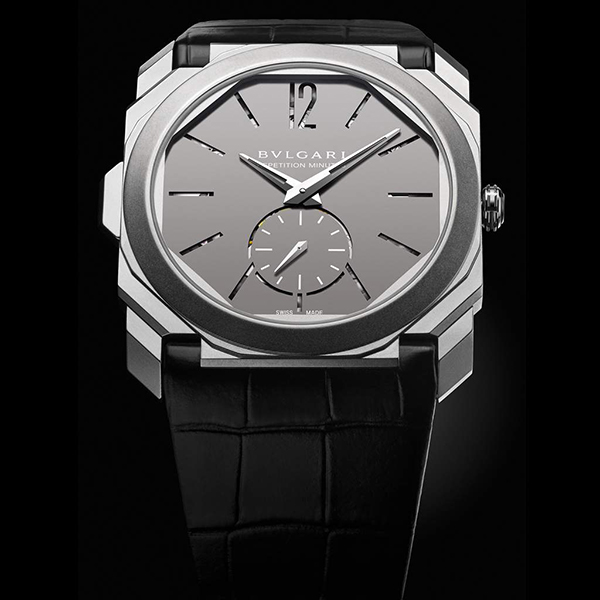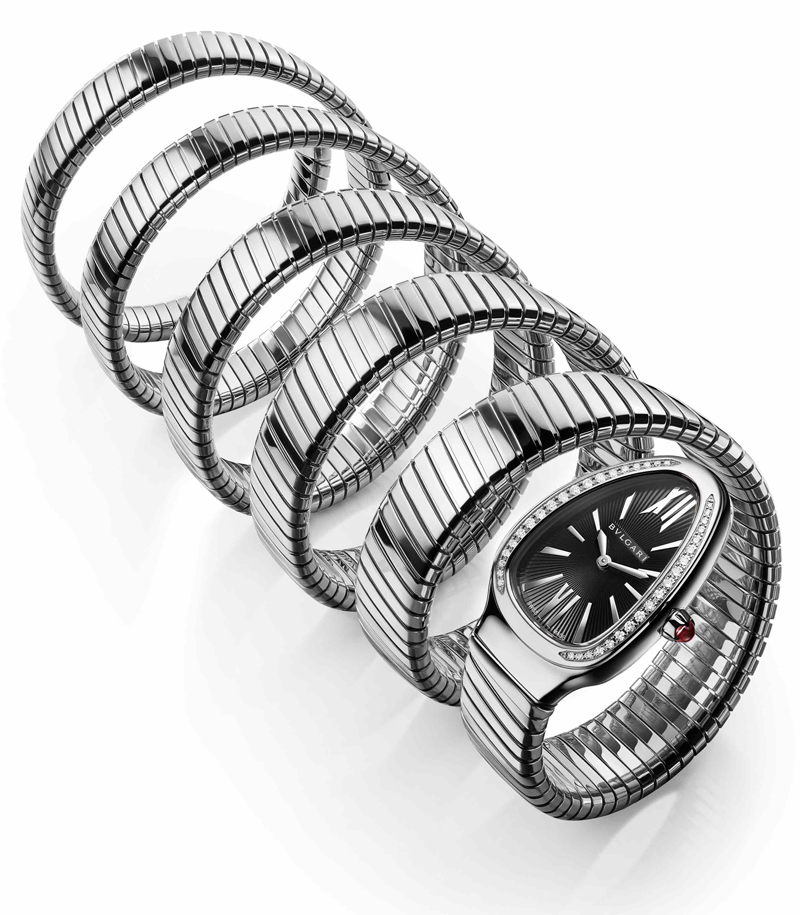Bulgari sent watch designer Fabrizio Buonamassa Stigliani to represent the brand for its first appearance at the DWW. He was born in Naples, then moved to Rome. He is imbued with Italian design, and speaks about it with passion. Now settled in Neuchâtel with his family and his team, he works within the constraints of watchmaking, Bulgari’s stylistic codes and his own aesthetic sensibility, which he uses as sources of inspiration.
How is Bulgari’s first participation in Dubai Watch Week going?
It’s the first time we’ve taken part in the fair, and it seems to offer good visibility. Dubai is an interesting city, full of energy and ideas. I had an opportunity to visit some of the less glamorous areas. It was a big contrast, and very inspiring.
It’s interesting to come and talk about watches outside of Switzerland, to bring watch culture to an event whose primary goal is non-commercial. What’s more, the surroundings and the workshops are quite informal, which is great. The panel discussions are interesting. Also, I thought it would be good to tackle more subjects of interest to women during the forums. Men and women have a very different approach to objects. Women have a more emotional reaction (my wife, for example, either likes something or she doesn’t!), while men probably have a more mechanical approach. I spoke in one of the forums about inspiration, on the theme, “Time as an intangible muse.”
So, do you have a muse? What inspires you?
A little bit of everything I see! What a designer produces is the sum of all the things that surround him, his experiences. That’s what his heritage, his DNA, are made of. I’m never afraid of a blank page!
I always have my pencils with me. I’ve created watches in Hong Kong, or in Moscow airport. I might start sketching a tree, or a pair of glasses, and it ends up being a watch! I never know where my pencil will take me. Here, I was drawn to the towers opposite (the Emirates Towers), their architecture. The place where we’re sitting (under the arch of the DIFC) is also fascinating. Even this piece of art speaks to me (a chrome sculpture in front of the watch tent), and if I approach it wearing my industrial design hat, it even looks a little like an engine part.
Which aspect of your work do you enjoy most?
The idea of making a start, of new beginnings. Thunderbolts, flashes of lightning. You have to be able to seize ideas in the moment, because if I have nothing to draw with, they vanish into thin air.
You started out in the car industry. How do you cope with having to work with the restricted dimensions of a watch?
The jeweled elements of each jewelry timepiece are created either at the Bulgari Jewelry manufacture in Valenza or in the High Jewelry Workshop in Rome, determined from the watch’s attributes and its own preciousness. When it has to do with the jeweled bits, the type of manufacturing carried out is your traditional lost-wax casting technique. Professional goldsmiths clean, assemble, and finish all the metallic elements, giving shape to the true watch, including bracelets (that we’ll discover in greater detail in an upcoming article dedicated to the Serpenti) and also stone-set cases.Special attention is paid to details, since it is fundamental that every component perfectly interlocks with others, after the natural movement of the wrist, also which the clasps and configurations are expertly realized. Experience and expertise are essential during the delicate period of placing the gems, to make certain that every stone is securely anchored in position. The watch component itself is assembled in Neuchâtel, Switzerland, where the motion is excavated along with the last excellent control is carried out.Announced at December 2015 and set to be inaugurated by early 2017, Bulgari will open its enlarged and fully incorporated jewelry fabrication in Valenza, a state of Alessandria, Italy. Forming a bridge between tradition and innovation, the complex will incorporate the Goldsmith’s Farmstead, originally constructed and used from the very first jewelers in the region in the early 19th century, as well as a completely fresh, three-story construction, with a 600-square-meter lawn for natural lighting plus ventilation.All designed to be absolutely sustainable (and LEED certified), this new complex is going to be the biggest jewelry manufacture in Europe, supplying over 700 craftsmen with space to help create an ever greater amount of Bulgari jewelry pieces, in order to cater to the ever growing market demand. The all-new Bulgari Academy, to be set in Valenza, will assist the brand to further train workers and freshly hired craftsmen, perpetuating the skills and crafts required to produce these high jewelry creations in house.
Restriction can be an opportunity. Even within that small space, everything is important, even music, sounds. I’m thinking of the Octo Minute Repeater: you can read the time anywhere, in the subway, wherever, but when you press that button and you hear the hammers and the gongs, it’s an entirely different emotion. You can read and hear the time! For a designer, the constraints of thickness, space and materials all have an influence, and they create opportunities.

Octo Finissimo Minute Repeater © Bulgari
But creativity is not a democratic process. I work with my team, and sometimes I have to insist. I know that an idea makes sense for Bulgari and that it’s innovative, so I push ahead. That was the case with the Octo Finissimo Automatic in titanium: it’s masculine, formal, in keeping with Bulgari’s DNA and utterly out of the ordinary. It’s essential that my personal taste corresponds to the “taste” of the brand, otherwise it wouldn’t work!
How many people do you have working in design at Bulgari? Does the jewellery team work with the watch team?
There are around eight people working in jewellery design in Italy, and four in Switzerland. Six years ago, we moved from Rome to Neuchâtel. Just think: for the Serpenti, the head is made in Switzerland (so that it can have the Swiss Made label), and the body is made in Italy. Each element is produced by teams in different locations, with different quality control standards and different tolerances. We sometimes have friendly arguments! Everyone has to comply with the rules on both sides.

Serpenti © Bulgari
What would you like participants to retain from the design master class you’re giving here?
I’d like people to gain a sense of the importance, for a designer, of being able to combine the brand’s stylistic codes and play with the limitations and style – to do all that and remain innovative. We’re going to have fun making watches out of paper!